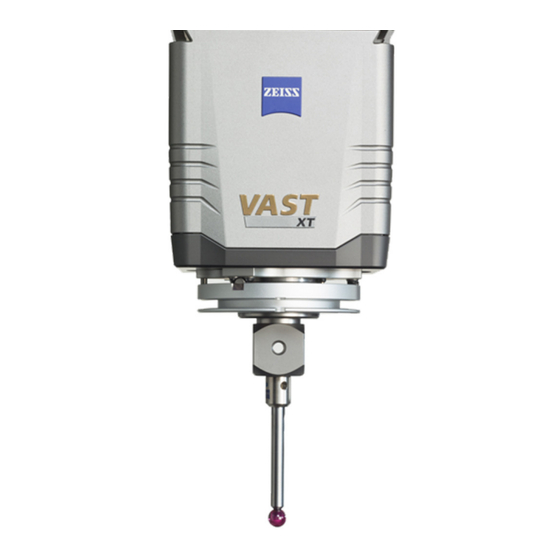
Table of Contents
Advertisement
Quick Links
Advertisement
Table of Contents

Summarization of Contents
Preface
About this document
Explains the purpose and scope of the operating instructions.
Configuration of safety instructions
Details the types and components of safety instructions used in the manual.
Markup elements
Describes text formatting conventions used throughout the document.
Chapter 1 Introduction
Delivery package
Details the contents of the probe and stylus system kits upon delivery.
Warranty and standards
Outlines warranty information and applicable standards for the probing system.
Chapter 2 Safety
Intended Use
Defines the proper and intended usage of the probing system.
Basic safety instructions
Provides essential safety guidelines and warnings for operating the probing system.
Chapter 3 Description
Overview
Introduces contact probing systems, distinguishing between trigger and measuring types.
RST-P
Describes the RST-P probe, including its product photo, application, and components.
XDT TL3
Details the XDT TL3 probe, covering its application, system requirements, and components.
VAST XXT
Describes the VAST XXT probe, including its application, system requirements, and components.
VAST XT gold
Details the VAST XT gold probe, covering its application, components, and limit values.
VAST XTR gold
Describes the VAST XTR gold probe, including its application, system requirements, and components.
VAST gold
Details the VAST gold probe, including its application, components, and limit values.
TP6
Describes the TP6 probe, including its application, system requirements, and components.
TP20
Details the TP20 probe, including its application, system requirements, and components.
Stylus systems
Explains stylus system components, combinations, and types.
Chapter 4 Technical specifications
RST-P
Lists the technical specifications for the RST-P probe.
XDT TL3
Lists the technical specifications for the XDT TL3 probe.
VAST XXT
Lists the technical specifications for the VAST XXT probe.
VAST XT gold
Lists the technical specifications for the VAST XT gold probe.
VAST XTR gold
Lists the technical specifications for the VAST XTR gold probe.
VAST gold
Lists the technical specifications for the VAST gold probe.
Renishaw probes
Lists technical specifications for Renishaw probes.
Chapter 5 Handling
What you should know!
Provides general information and tips for handling probing systems.
Notes on measuring operation
Offers guidance and considerations for effective measuring operations.
RST-P
Covers handling aspects specific to the RST-P probe.
RST-T
Details handling procedures for the RST-T temperature sensor.
VAST XXT
Discusses handling and operational notes for the VAST XXT probe.
VAST XTR
Covers handling aspects, configuration, and mounting for VAST XTR.
Stylus system assembly
Explains precautions and methods for assembling stylus systems.
Installing the stylus system
Provides step-by-step instructions for installing stylus systems.
Chapter 6 Errors and Malfunctions
Faults during operation
Lists common errors, their causes, and remedies for the probing system.
Chapter 7 Care and inspection
What you should know!
Emphasizes the importance of cleanliness for the measuring system.
Inspection measures
Outlines regular checks and maintenance for stylus systems.
Care and cleaning
Provides detailed instructions for cleaning stylus tips, adapter plates, and probes.
Chapter 8 Disposal
Package
Refers to country-specific regulations for packaging material disposal.
Disposal of probing systems
Explains proper disposal methods for electronic components in accordance with WEEE.
Appendix
Webshop
Provides information about accessing probe accessories and training materials online.
Order numbers
Lists order numbers for various components and accessories.
















Need help?
Do you have a question about the VAST XTR gold and is the answer not in the manual?
Questions and answers